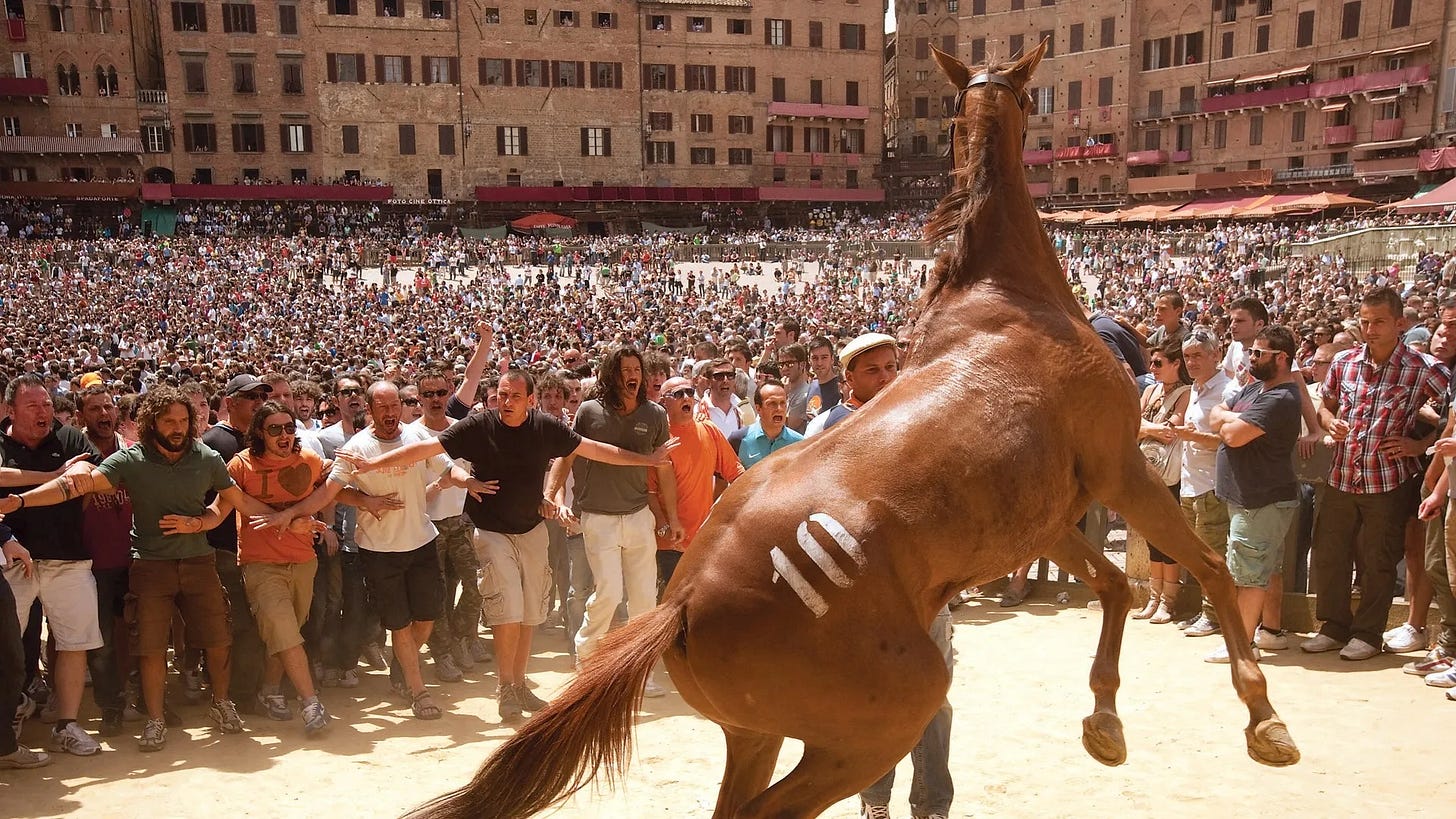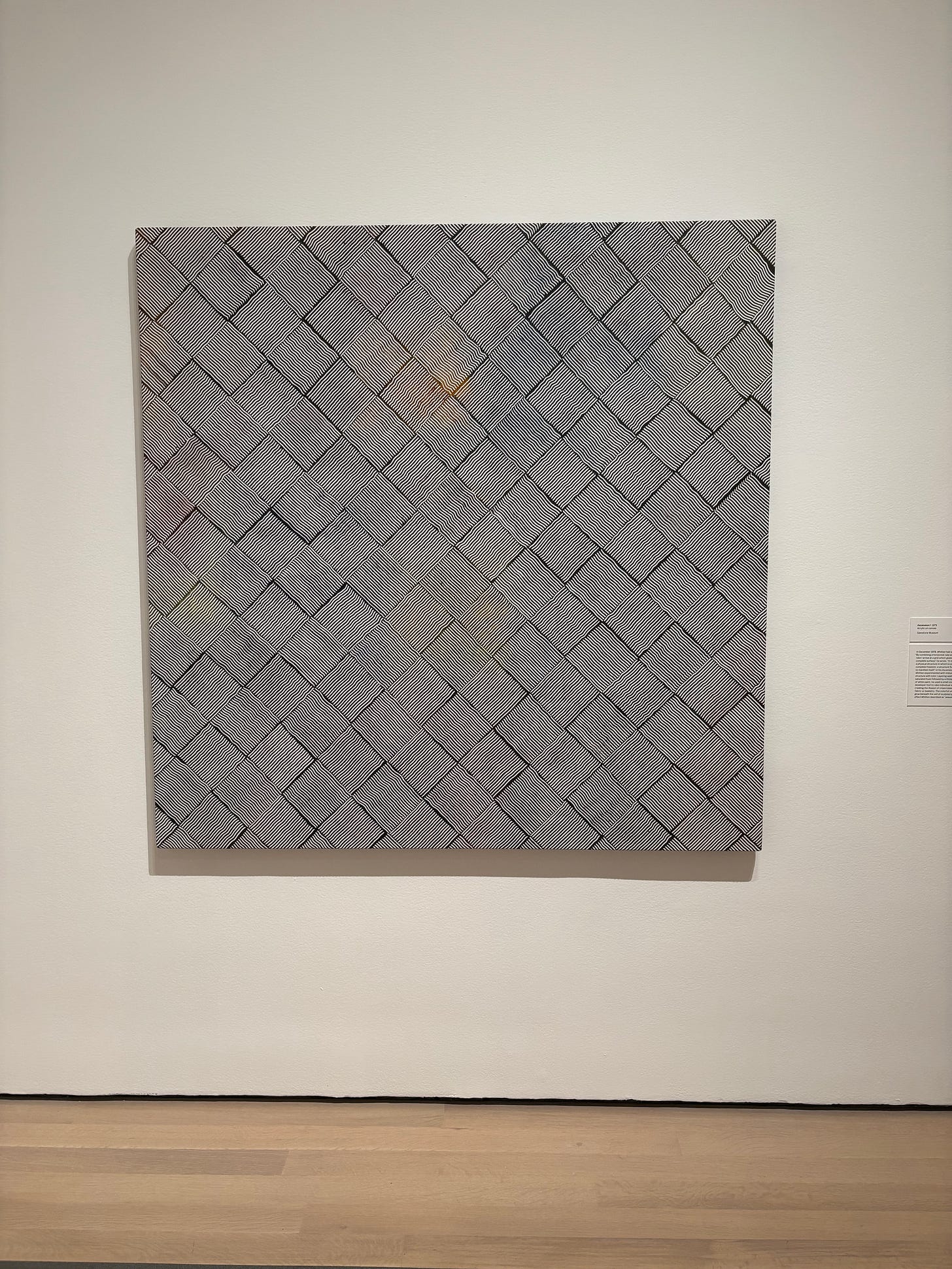Minuets and The Messenger
Jack Whitten, guitarist Noël Akchoté, and an answer to the question "Does Pinot Grigio always have to suck?"
Readers: The Spigot has been dribbling a little slowly of late, for a couple of reasons. One reason was that Frieze came to New York and I wrote about it not here but in my second-favorite publication, Cultured, for their Critics’ Table section. The grueling diaristic account features an exceptional depiction of an octopus; the sprawling show R U Still Painting???; the incomparable Gillian Welch and David Rawlings; a careening party where a younger writer told me I was living history (complementary?); and recurring cameos by my favorite Estonian, whose music has had a bit of a viral moment on TikTok in the weeks since.
Moreover, I’ve been scrambling to finish up some work and otherwise prepare so that I may head to Siena, Italy, for Amant’s Studio and Research Residency for the summer. I may have mentioned this trip before, but to reiterate: I was exceedingly fortunate to be selected by the foundation for the opportunity to sequester myself for a while and focus on writing—a book project that I’ve wanted to get off the ground for a while now. You apply for dozens of things and get like 2% of them. I’m incredibly grateful.
When does all this mean for Spigot? The volume should remain typical, especially given that June through August gets a little slow anyway. Probably there will be fewer art shows and more books, since I’ll be hunkering down in a pile of them. Maybe—as a treat for paying subscribers?—I’ll even post some of the writing I’m generating while out of the country. You can also expect the wine selections to skew toward Chianti and Vernaccia.
Art
If you’re a regular reader of Spigot, you’ll know that I’m one of those people who, when everyone runs in one direction, I start tiptoeing backward. As much as it goes against my nature, however, I can only report—with pleasure—that everyone’s favorite current exhibition in New York, Jack Whitten at MoMA, is very very good.
If I don’t know a painter’s work well, especially when they’re someone being historically reappraised, elevated to their proper stature for the first time, etc., I tend to look first for chops, sparks, fireworks, virtuosity. If you are similar (similarly shallow-minded?), you will be instantly hooked by Jack Whitten. There are chops galore. I once had an editor for a magazine I will not name intervene in the editing of an interview because I called my interlocutor a “motherfucker.” I had to explain that it was a compliment. Thus I hope you get the gist when I say Whitten is a motherfucker.
There’s far more than technique, however. The paintings are intellectually restless as well as visually consummate, and there are tons of them, including some that (cough cough) anticipate Richter’s blurred abstractions. It’s all heady and palpably yet obscurely invested in the spiritual. His later mosaic work maintains the same intensity. It’s shocking that Whitten was overlooked for so long—except, you know, racism. The syncretism of his lab-scientist methodology, continuous exploration, esoteric thought, and politics make the work unique. I walked through it, exited, then walked through it again. When you go, give yourself time to luxuriate.

Like everyone else I must shout out Michelle Kuo as well as whomever handled the exhibition design. The latter creates appealingly oblique sightlines with brief freestanding walls and wooden frames that you may traverse as if you were traipsing through invisible sheet rock. It feels a bit midcentury, in a refreshing and humanizing way. The curation, meanwhile, perfectly balances social context, personal detail, and the nitty gritty of what was going on in the studio. Maybe I’m a nerd, but I loved seeing Whitten’s tools and learning about his techniques. You could imagine those subjects might not be of great interest to a broad audience like MoMA’s, but lots of people are tinkerers and, I suspect, can identify with the creative impulse articulated as something comparable to household repair.
At the same time, the tactility and toolmaking that the show foregrounds seem especially piquant at a moment where daily life feels so dematerialized. Maybe Whitten is the last artist who we’ll ever be able to make a show like this for, one that emphasizes the ingenious devices and manual tactics that yielded the exceptional paintings on view. Maybe the true message of The Messenger is that making things by hand is ready to be put in a vitrine and shown off like a relic.
Wine

Castel Sellegg Pinot Grigio 2022. Can pinot grigio be good? Obviously not. It’s a foul, sour wine served at bad art openings, the European equivalent of California Chardonnay, with the worst of it bulk produced in the Italian Veneto region. The grape’s mockable status led to its immortalization in Bernadette Corporation’s other novel, Eine Pinot Grigio, Bitte. No, I actually haven’t read it, though I do have a copy in storage somewhere—accruing value by the day, no doubt.
And yet, as if to prove the point that—like [insert your least favorite critic here, or me if you’re hate reading]—even stopped clocks are right twice a day, there exists Castel Sallegg, a winemaker in Alto Adige, a majority German-speaking province of Italy that borders Austria. This is the Dolomites, where Italians with names like “Jannik Sinner” come from. Royalists, take note: Castel Sallegg remains in the hands of the Kuenburg family, whose genealogy includes Carlos aka Charles III of Spain and Marie Antoinette. They grow a variety of wines at reasonable prices—most notably, to me at least, a very good pinot grigio.
Sallegg pinot has, like Jannik Sinner’s urine after a grueling match like the one he’s about to contest at Roland Garros, a thick but health yellow color of the sort frequently described as “strawlike” by oenophiles. It’s balanced and fruity, with a touch of creamy mango and a manicured-fingernail bump of white pepper, and an acidity tending toward that of a top-notch riesling. It reminds me a bit of chenin blanc in its traction and the way it darkly limns a bright gustatory experience to let you know that, while it all worked out this time, something could have gone horribly wrong. Poignant! The wine is a great deal for the price, though it may be hard to find.
Music
Getting ready to leave NYC for more than a couple weeks while also tying up some commitments is stressing me tf out. Luckily I discovered the stylings on guitar (and other stringed instruments) of Noël Akchoté. He records his own music, but a lot of the work is repertory, ranging from classical to Anthony Braxton (who celebrated his 80th birthday yesterday) and LaMonte Young. Shoutout to the source of my discovery, the sublime @bob_hope1234567, whose deranged gif collages posted as IG stories often feature or focus on music worth listening to. I’ve found Akchoté’s The Notebooks of Anna Magdalena Bach arranged for dobro to be very soothing, both because the intricate counterpoint of baroque music hits me like a brain massage and because, well, it’s a dobro.




